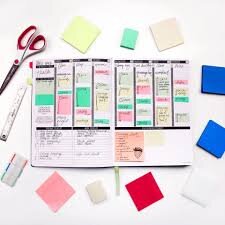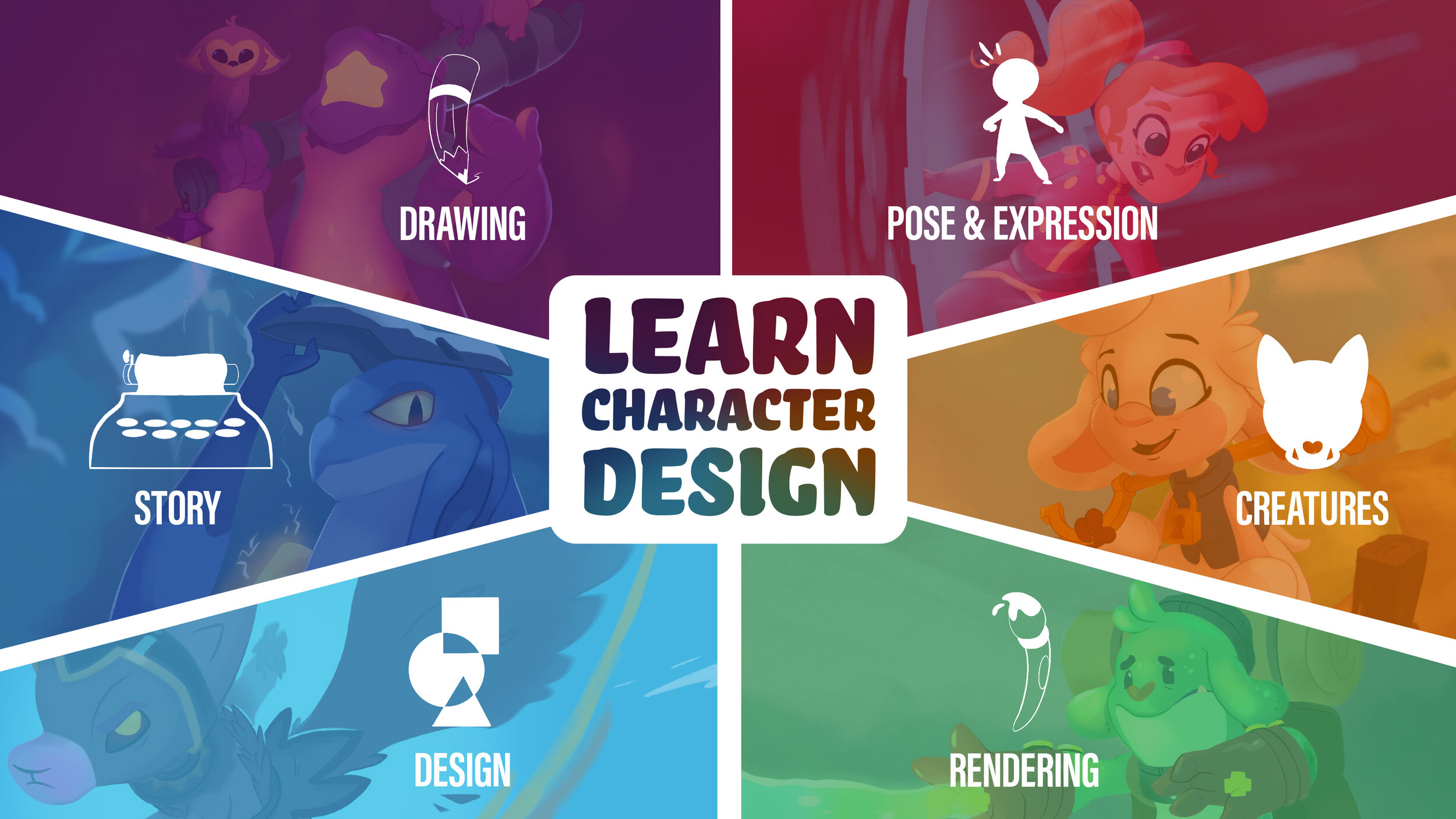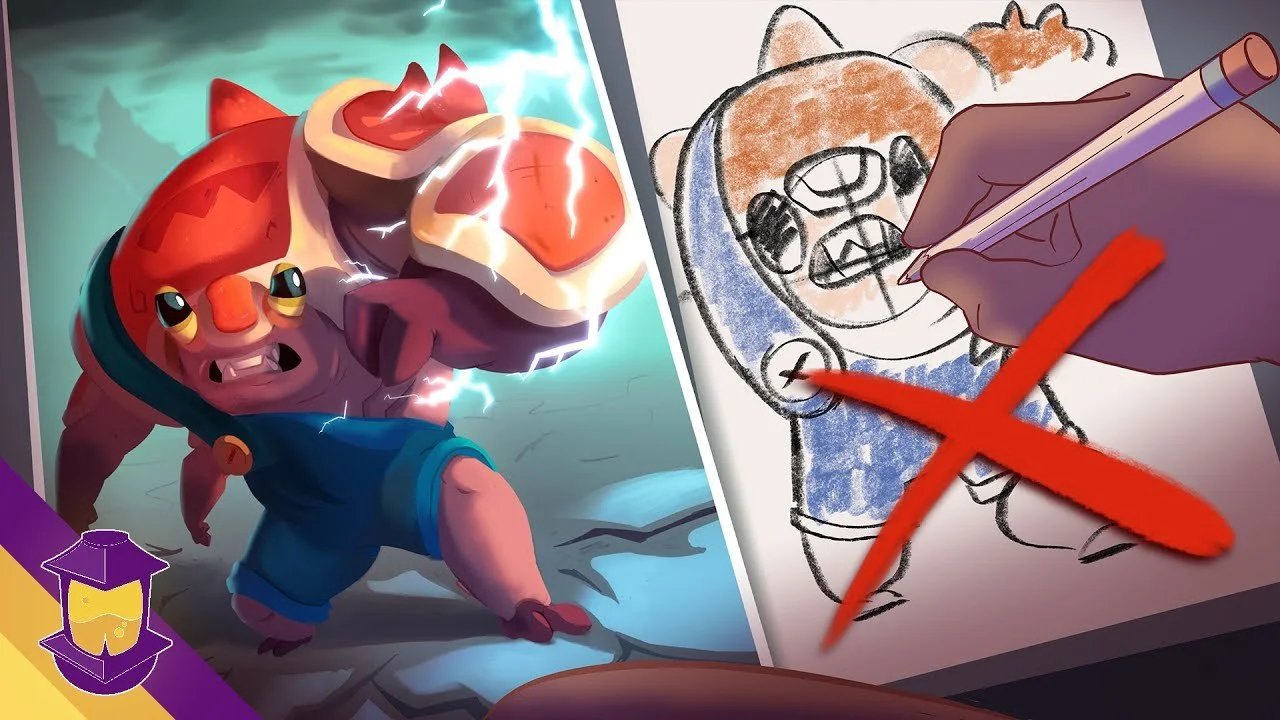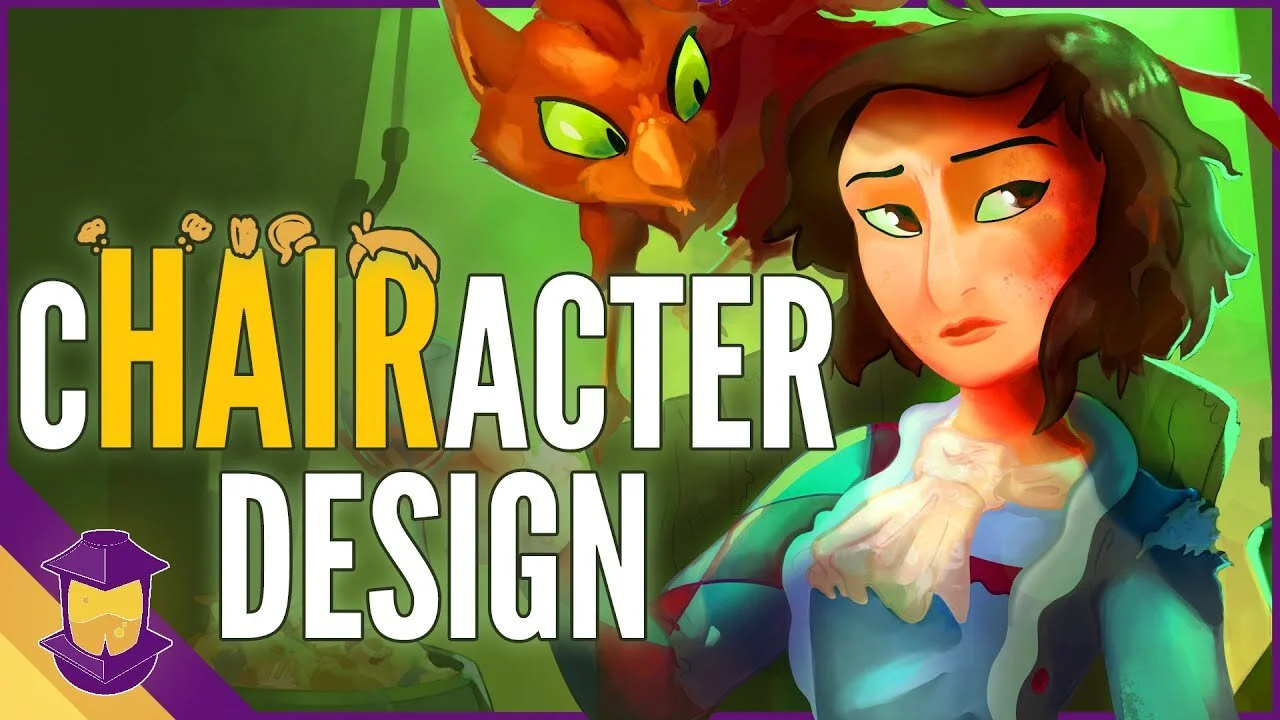As artists, we move between a couple of different modes and missions: seeking to improve, wanting to complete big projects, and whatever sort of ball we yearn to become on the couch.
I’m sure there’s a project motivating (or pricking) you to work.
Maybe it’s a comic project, maybe it’s a series of daily art pieces, maybe it’s a game or animation.
As someone with a few projects under their belt, I thought we’d talk about a few things to keep in mind during your creative endeavor.
I’ll share the big projects I’m working on to give you some insight and provide something of a catchup point (because a lot of people have been asking recently and I want to give them something to point to).
Watch this video now!
Let’s Talk About Passion
Because it’s definitely something that you have before you start your project, but as the hard work sets in, it’s easy for that passion to start to fade.
The grass looks a whole lot greener when you’re 75% of the way through a project, but when there’s nothing but hard work left to do your zeal fades. Or 9 times out of 10, you start to feel meh about the project you’re currently doing because it’s not perfect.
What’s happened is that the hypothetical dream project has turned into a concrete thing before your eyes - flaws, mistakes, and all.
So a sparkly new idea floats by, captivating and distracting you, and because of the state you’re in, any idea seems better. And you’re tempted to bite.
Instead of biting the shiny new idea, do this:
Briefly record that new idea in a journal or Word doc
Then keep moving forward with the hard work you need to do to have something complete under your belt.
Finishing the last 25% or even 10% can probably be the toughest spot for any working creative, so know that you aren’t alone. But this is one of those cases where it’s worth fighting for something of value.
But, can you avoid even reaching this desperate point in the first place? Yeppers.
Let’s get into a few proactive things that you can do to spread the weight around.
Let’s Talk About Making Projects More Sustainable
Some of the most valuable work you’ll do is at the beginning of your project. And one of the worst mindsets you can have going into it is “eh, I’m sure I’ll figure that out when I get to it.”
Of course, you don’t have to have every little thing planned out from the start. But let me ask you this hypothetical: have you ever added a coat of paint to something in hopes that it would solve a problem underneath?
Kind of like with this model of my game character Jacqueline’s key, it’s the first time I’ve ever used EVA foam. And sure, it looks passable from far away, but up close you can see the places where I thought the plastidip, or primer, or paint, or even the glossy coat would finally solve those imperfections.
In projects, 9 times out of 10 those problems are like the Princess and the Pea: the issue doesn’t go away no matter how many mattresses you stack on top of it.
The problem with most beginner artist’s work has to do with that initial sketch that they spent hours polishing, hoping that the paint will smooth things over. And the problem with most big projects are the issues you don’t address early that won’t just magically go away later.
(Interested in mapping out a solid story concept for your comic? Check out this video on Writing and Preproduction for Comics)
With Jaq’s key, I wasn’t working with the right tools for this work.
For a comic project…
It might be that you didn’t do enough preproduction and don’t really know what your character looks like from the side.
(Want to improve your character’s look from different angles? Watch this video on Creating Character Turn-Arounds)
With a Daily art project…
It might be that you have ideas for the first 4 or 5 days in the series but, “eh, I’ll figure the rest out when I get to it”.
These are the things that will not get better with age. Make sure you address them.
Let’s Talk About Avoiding Drop-Off Syndrome with your Story
Speaking of planning in general, one of the hardest ways to complete a project is by starting at point A and meandering your way to point B.
This might look like sitting down to write your story beginning on page 1 and not having any kind of planning in place.
Of course, these things could always change, but it helps to have a more zoomed-out plan that has an end in sight.
So for a story…
Plan for the ending. Plan out what you want your characters to go through, the main beats you want to hit. Try breaking things down by chapter.
Instead of stressing through a long outline, try this:
Make a post-it note wall of your storyline. Include simple scenes up to complex plot twists.
With the post-its, edit and manage your story like a set of lego bricks. Move, connect, replace, and remove as you see fit without doing heavy editing damage.
When I was first trying to make a success of my long-term storytelling, I made a big post-it note wall of my storyline with the simple overall things I wanted to happen in each of the 6 chapters, all working towards the ending in mind.
This setup helped me when I wanted to make changes too. I simply shifted the post-its around. It made editing and scoping my story so much clearer and easier. Having that armature was a huge help.
This applies to more than just stories too.
If you have something like an animation in mind, start with a few bigger post-its (AKA the larger categories) things like writing, preproduction, the actual animation itself, post-production like editing, rendering, and compositing. All to give you a map of what you’re working towards!
(Interested in improving your rendering skills? Check out Module 6:Rendering in the Learn Character Design Course. It will teach you the fundamentals of rendering step-by-step and help you become a master of your own concepts.)
When it comes to planning and time, set a realistic time goal for yourself, and then add at least 50% to that.
You never know what complications will arise, what things will get in your way of spending time on it—and again, talking about passion—you might move a lot quicker early on when you’re planning, versus later on in the trenches.
So let’s Talk About Minimum Viable Projects
I’ve talked about minimum viable projects before and I even mapped out what qualifies them in each medium,(here’s that video here) and even if you aren’t trying to fit your project into the tiniest package, I think it could help to map out what your project entails. Are there 4 characters or 20? Is it set in 1 location or 12?
There’s something of a sliding scale for how expensive of a budget, (swap out money for time if you’re doing this yourself) that these projects can take.
For a Written Story…
You can easily fill 200 pages with words describing the most detailed, intricate, involved, hard-to-animate story.
With a comic…
You might spend the same amount of time on only a dozen or so pages, with limits to the amount of dialogue you can fit, or scenes you can successfully render.
For Animation…
You might spend the same amount of time on 30 seconds or 1 minute of playback. So even if you aren’t aiming for tiny, plan realistically. If you’ve never animated before, singlehandedly producing a feature-length film on your first try is going to take so long that it might be impossible.
I said at the beginning that as artists we tend to cycle between project ambition and desire to learn, and I think projects are a great way to pick out one thing that you want to learn and use the project to teach it to yourself.
Just be careful: teach yourself ONE thing, not ten things. Doing the opposite is a really great way to overwhelm yourself and halt the project before it even begins.
Let’s Talk About Feeling Overwhelmed
Look, I know how ambitious these big projects can seem. If these tips have you feeling down because you’re just trying to survive right now, please don’t feel bad. I am by no means trying to make you feel guilty.
Trust me, as much as I have managed to maintain output this year, to borrow an expression, this still duck on the water is doing a HECK of a lot of kicking below the surface.
This post is meant to help if you are aspirational or want to channel that drive to make something more effectively.
And let me make myself very clear: if you’re even trying to take a step forward on a creative project during one of the most miserable years to date, YOU ARE DOING GREAT.
Let’s Talk About Projects We’re Developing Here at Character Design Forge
Just like you, my wife and teammate Tay, and I have a lot of work on our plates. The videos that we drop on the Character Design Forge Youtube channel every Sunday take a ton of time, I have monthly projects like Biko’s Backpack and commissions and client work, but, when I’m able to, I am currently working on Shackleton and Stormfellers, two projects I am very excited about. Plenty more stories we want to share, and things we want to do, but for now, we’re focusing on these two. So allow me to share these two big projects with you!
Shackleton
Shackleton is a videogame my buddy Mark and I are developing, about a lamb named Jacqueline, whose island home has been turned in to a giant prison complex.
She wields a giant key to liberate her fellow people that have been wrongfully locked up.
We’ve been working on this for a while, and we restarted development not long ago. At first, we had plans of this being a 3D game, but there were a couple of issues with that.
Yes, we could get player movement and physics, yes I could model and retopologize and texture and rig the characters. But the time that it took to both code and create the assets in 3D was way too much for the scale and scope that we want to work in, and, ultimately we weren’t realizing our vision for the game in 3D.
So we took a step back, and as soon as we shifted the perspective, so many things started to fall into place.
The change in art from 3D to 2D meant that creating assets was much quicker.
The loss of a dimension for Mark makes programming that much simpler. And the mechanics of the game—the thing that makes it fun and kind of makes it the most important— got a lot clearer.
I know that a lot of people have been waiting for updates on this, we want to be able to show you something soon, just please understand, especially with the past year, we’ve had some hiccups and delays but are excited to keep working on it.
STORMFELLERS
Stormfellers is a project that DOES have a date in mind: 2021. Stormfellers is a story set on an island that is plagued with frequent storms, and parties of intrepid adventurers from the Stormfellers guild team up to take these storms down. These teams have big tanks, specialists, and a very special creature called a Storm Conduit that can absorb the power of a storm. But instead of focusing on any of them, our story centers around the support class, a field medic, named Biko.
Biko is made of a healing goo, so he literally gives of himself to heal others. On top of the fact that his job is nowhere near as flashy as everyone else’s, the rest of his team is absolutely insufferable to be around.
I’m keeping some things about this project close to the chest because, as someone who releases content every week, I like having some surprises in store.
But I will say that I’ll have some behind the scenes progress on the project available in this month’s vlog, which is exclusive to patrons and newsletter subscribers. So if you want in on the fun, make sure you’re one of those! ;)
And, well, that’s it for today, folks! Be sure to share this article with any friends who may be struggling with their creative projects and help give ‘em a boost!
And answer me this!:
What Projects are you working on right now?
Let me know in the comments section below, I’d love to hear what you’re working on!
Do you Want to Master your Digital Art and Character Design Skills?
You Can Do it in Just Six Steps
Hey! I’m Brookes Eggleston…
If you’re new here, welcome! I’ve worked in studio settings and in a freelance capacity as a Character Designer, Illustrator, Story Artist, and 3D Modeler for nearly 15 years. But what I love as much as drawing characters is sharing what I’ve learned. Get to know my mission here at Character Design Forge.



























